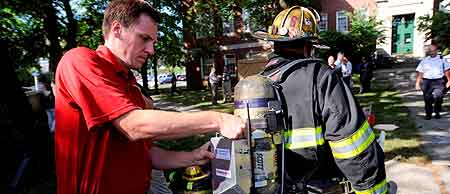The Geospatial Location Accountability and Navigation System for Emergency Responders (GLANSER) is the “closest it has ever been” to being marketed, observed Worcester (MA) Deputy Fire Chief John Sullivan after viewing the system’s most recent performance testing. He and other emergency personnel; scientists, researchers and product developers; and government officials, including Jalal Mapar, program manager for the Department of Homeland Security Science and Technology Directorate (DHS STD) witnessed the successful conclusion to a training exercise at Worcester (MA) Technological Institute on August 7 in which searching firefighters simulated the “rescue” a lost firefighter using the GLANSER.
The event was held during the Seventh Annual International Workshop on August 6-7. This was the first-ever public demonstration of the DHS personnel location and tracking technology, according to WPI. The system’s development was spurred by the death of six Worcester firefighters in December 1999 in a fire in the former Worcester Cold Storage and Warehouse Co. Worcester fire officials believe that those firefighters could have been saved with the technological advance represented by GLANSER. Sullivan and Fire Engineer (Ret.) Ric Plummer, Berlin, Massachusetts, oversaw operations during the rescue demonstration.
The GLANSER, the size of a football, is attached to the firefighter’s breathing apparatus (photo 1). It can track and locate firefighters in three dimensions within multistory buildings using a fusion of technologies, including an ultra-wideband ranging radio, an inertial measurement unit, a Doppler velocimeter, and a barometric altimeter. A mesh network that uses individual firefighter navigation units as nodes transmits location information to the incident command station. Firefighters’ locations and the tracks they followed are displayed on monitors at the command post (photo 3).

(1) A Honeywell representative mounts a location and tracking unit on a Worcester, Massachusetts, firefighter’s breathing apparatus. (Photos courtesy of Worcester Polytechnic Institute.)
DHS is funding the system, which has been developed by Honeywell (navigation solution); Argon ST of Fairfax, Virginia (the radio and networking communications system; and TRX Systems of Greenbelt, Maryland, (the display and mapping technology. WPI researchers developed and tested indoor location technology and technology for monitoring firefighters’ vital signs.

(2) A Worcester (MA) firefighter guides himself along the floor of a campus building during the rescue demonstration.

(3) (l-r) Rob McCroskey, senior scientist, Honeywell; Bill English, vice president of Products and Projects, TRX Systems of Greenbelt, Maryland; and John Sullivan, deputy fire chief, Worcester Fire Department, review firefighters’ locations on a monitor during the rescue demonstration.
DHS-STD’s Mapar says, “The goal is to bring the GLANSER system to market in the next year or so.” Sullivan agrees that marketing time appears to be closer than ever, even though “the system still has issues that need to be addressed before it is ready for deployment.” He added that the technology is not meant to replace traditional firefighting techniques but will “serve to augment their training.”
The first inaugural workshop on precision indoor location and tracking was held in 2006. Since then, WPI explains, “The workshop has brought together first responders, researchers, and representatives of industry and government to assess the state of the indoor location field and demonstrate prototype systems (including WPI technology). Each year, the goal of a successful location system seemed just a bit closer.”
“We recognized early on that this was an enormous technical challenge,” says James Duckworth, associate professor of electrical and computer engineering at WPI and a member of the conference-organizing committee. “No one group of researchers could tackle it on its own. Through this annual workshop, we have fostered an engaged and active global community all focused on solving the problem and giving first responders the technology they need to do their jobs with greater safety.”
Fire officials recently have been working with WPI’s Fire Protection Engineering Department also on other technology that can increase first responder safety. One example is a sensor that can predict the onset of flashover. WPI’s work has been supported by funding from the Departments of Justice, the DHS, the Federal Emergency Management Agency, and other federal agencies.
MARY JANE DITTMAR is senior associate editor of Fire Engineering and conference manager of FDIC. Before joining the magazine in January 1991, she served as editor of a trade magazine in the health/nutrition market and held various positions in the educational and medical advertising fields. She has a bachelor’s degree in English/journalism and a master’s degree in communication arts.


